
* While fighter aircraft tend to become larger and more expensive as their users demand more of them, there have always been a few aircraft designers who believed that a simple, lightweight fighter might find a useful niche. One of the more interesting of these lightweight fighters was the British Folland (later Hawker-Siddeley) "Gnat". Although it was never used as a fighter by the British Royal Air Force (RAF), it did achieve success with the RAF in its "Gnat T.1" trainer version, as well as wide recognition as the mount for the RAF Red Arrows aerobatic team.
The Gnat also achieved export success, particularly with India, which manufactured the aircraft under license. In fact, the Indians found the Gnat so capable that they designed and built their own improved version, the "Ajeet". This document provides a history and description of the Gnat and AJeet.
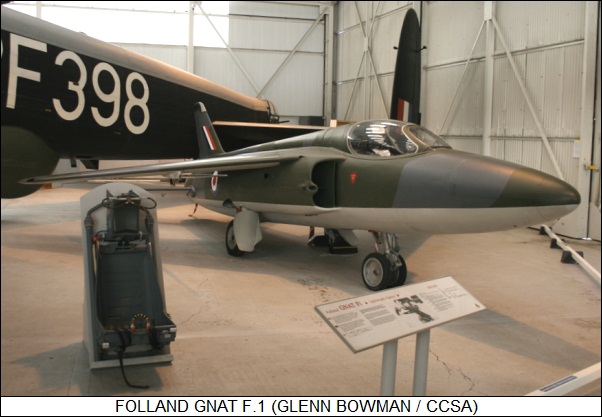
* The Gnat was the creation of W.E.W. "Teddy" Petter, a British aircraft designer who had gained wide recognition for his design of the English Electric Canberra bomber and Lightning supersonic interceptor. Petter had grown suspicious of the trend towards bigger and more expensive combat aircraft, perceiving that a small, simple fighter would offer the advantages of low purchase and operational costs. New lightweight turbojet engines were being developed that would be able to power such small fighters.
Petter was unable to pursue this vision at English Electric, so he left to become managing director of Folland Aircraft. In 1951, using company funds, he began work on his lightweight fighter concept, which he designated the "Fo.141 Gnat". The Gnat was to be powered by a Bristol BE-22 Saturn turbojet with 16.9 kN (1,724 kgp / 3,800 lbf) thrust. However, the Saturn was canceled, and so Petter's unarmed proof-of-concept demonstrator for the Gnat was powered by the less powerful Armstrong Siddeley Viper 101 with 7.3 kN (744 kgp / 1,640 lbf) thrust. The demonstrator was designated the "Fo.139 Midge". The Midge first flew on 11 August 1954 with Teddy Tennant at the controls, and proved an excellent aircraft.
The Midge had a number of advanced features, such as hydraulically powered "flaperons"; main gear that could be used as airbrakes; and a one-piece canopy that hinged over an inner armored windscreen. Despite the underpowered engine, the little jet could break Mach 1 in a dive, and was very agile.
________________________________________________________________________
FOLLAND FO.139 MIDGE:
________________________________________________________________________
wingspan:
6.30 meters (20 feet 8 inches)
wing area:
11.61 sq_meters (125 sq_feet)
length:
8.76 meters (28 feet 9 inches)
height:
2.82 meters (8 feet 1 inch)
MTO weight:
2,041 kilograms (4,500 pounds)
maximum speed:
986 KPH (600 MPH / 522 KT)
service ceiling:
11,580 meters (38,000 feet)
________________________________________________________________________
The Midge was evaluated by pilots from Canada, India, Jordan, New Zealand, and the US Air Force, and was almost universally praised. The Midge had performed a total of 220 flights when it was destroyed in a fatal crash on 26 September 1955, with a Swiss pilot at the controls. However, the Midge had demonstrated that Petter's lightweight fighter concept had much going for it. Folland went on to develop a full-scale Gnat prototype, also using company funds.
BACK_TO_TOP* The full-scale aircraft, designated the "Fo.145 Gnat", performed its initial flight on 18 July 1955, again with Tennant at the controls. It was very similar to the Midge, but had a maximum take-off weight about twice as great. It was powered by a preproduction Bristol Orpheus turbojet with 14.6 kN (1,490 kgp / 3,285 lbf) thrust.
________________________________________________________________________
FOLLAND FO.145 GNAT:
________________________________________________________________________
wingspan:
6.73 meters (22 feet 1 inch)
wing area:
12.65 sq_meters (136.1 sq_feet)
length:
9.04 meters (29 feet 8 inches)
height:
2.46 meters (8 feet 1 inch)
empty weight:
2,180 kilograms (4,800 pounds)
max loaded weight:
4,100 kilograms (9,040 pounds)
maximum speed:
1,120 KPH (695 MPH / 605 KT)
service ceiling:
13,720 meters (45,000 feet)
combat radius with drop tanks:
800 KM (500 MI / 435 NMI)
________________________________________________________________________
The Gnat was armed with two 30-millimeter Aden revolver-type cannon, firing from the outer edge of the air intakes. While this arrangement might have suggested that the Gnat would be prone to engine flame-outs from muzzle gas ingestion, that did not prove to be the case; no doubt, the muzzle system had been carefully designed to deflect the muzzle gases out to the sides. The Gnat also had two stores pylons for drop tanks, 225-kilogram (500-pound) bombs, or unguided rocket pods.
The Gnat prototype was refitted with an uprated preproduction Orpheus engine to put on flight displays at the Farnborough air show that year. While the RAF had no requirement for such a machine, the government wanted to encourage Folland in their work, and so the British Ministry of Supply (MoS) ordered six prototypes of the full-development aircraft for evaluation.
The evaluation Gnats were powered by the production-spec Bristol Orpheus 701 turbojet with 20.1 kN (2,042 kgp / 4,502 lbf) thrust. Most of the test flights were conducted in the UK, though ground-attack trials were performed in Aden (now Yemen). The report from the RAF evaluation generally praised the Gnat's performance, but there were criticisms of its flight-control systems, and there was no consensus that the Gnat was what the RAF needed. The Gnat fighter never served operationally in Britain, though the MoS did order two more Gnats on top of the original order for six.
* The good press given the Gnat did open the way for export sales. Two were sold to Yugoslavia for evaluation, and thirteen were sold to Finland. The Finnish Gnats were delivered in 1958 and 1959, with two of them configured for reconnaissance, with noses carrying three 70-millimeter cameras. Finland operated its Gnats until 1972.
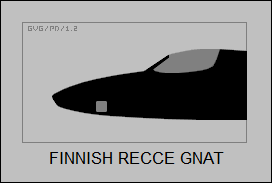
India was very interested in the Gnat, and in 1956 Folland and Hindustan Aeronautics Limited (HAL) signed an agreement for license production of the type, beginning a long love affair between India and the Gnat. 25 Folland-built Gnats, including two hand-me-downs from the RAF evaluation program, and 20 knockdown kits were sold to India through HAL. These machines were powered by the further uprated Bristol Orpheus 701-01 engine with 20.93 kN (2,134 kgp / 4,705 lbf) thrust.
The Gnat went into IAF service in the spring of 1958, with the first Gnat assembled by HAL from a kit flying in Bangalore on 18 November 1959. HAL then went on to build 195 Gnats themselves up to early 1974. The first completely HAL-built Gnat flew on 21 May 1962. IAF pilots were delighted with the nimble Gnat, which they felt was more than a match for Pakistani F-86s and MiG-19s, and nicknamed it the "Saber Slayer".
* The RAF had shown no real interest in the Gnat fighter, but Teddy Petter was persistent, proposing the tandem-seat "Fo.144" trainer version of the Gnat. The RAF liked the idea, and a contract for 14 preproduction "Gnat T.1" trainers was placed in 1958. The first performed its initial flight on 31 August 1959.
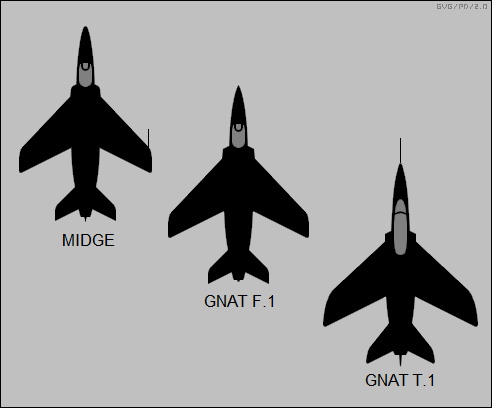
The Gnat T.1 had no gun armament, but retained the twin stores pylons. It was powered by a Bristol Orpheus 4-100 engine with 18.8 kN (1,920 kgp / 4,230 lbf) thrust. It featured a larger tail, plus a bigger wing with integral fuel tanks, 40% greater wing area, and conventional ailerons and flaps instead of flaperons.
________________________________________________________________________
FOLLAND FO.145 GNAT T.1 TRAINER:
________________________________________________________________________
wing area:
16.26 sq_meters (175 sq_feet)
length:
9.68 meters (31 feet 9 inches)
height:
2.93 meters (9 feet 8 inches)
empty weight:
2,331 kilograms (5,140 pounds)
max take-off weight:
3,915 kilograms (8,630 pounds)
max speed at altitude:
1,024 KPH (636 MPH / 553 KT)
service ceiling:
14,630 meters (48,000 feet)
range with drop tanks:
1,852 KM (1,151 MI / 1,000 NMI)
________________________________________________________________________
The RAF was pleased with the Gnat T.1 and ordered 91 more, for a total of 105. These were built between 1962 and 1965 by Hawker-Siddeley, which had bought out Folland since the government was strongly encouraging consolidation of Britain's aviation industry.
Five yellow-painted Gnat T.1s fitted with smoke generators were used in 1964 by the RAF "Yellowjacks" aerobatic demonstration team, which was redefined a year later to become the RAF "Red Arrows", with red-painted aircraft. Their nine red Gnats, trailing smoke during precision maneuvers, pleased crowds at airshows in Britain and around the world until 1979, when they converted to the British Aerospace Hawk, which also replaced the Gnat T.1 in the advanced training role.
The Gnat T.1 served the RAF well, though it suffered from high operating costs; it had not been designed for maintainability, and some of its systems were not noted for their reliability. Its cockpit was also cramped, and the instructor's forward field of view from the rear seat was poor. The BAE Hawk was designed specifically to provide the utility of the Gnat T.1, while lowering operational costs and eliminating some of the Gnat's defects.
BACK_TO_TOP* The Indians were very happy with the Gnat, but the little fighter did have its problems, the worst being that its hydraulics and some of its control systems were unreliable. In 1972, the IAF issued a requirement for an improved "Gnat II", at first specifying that the new version was to be optimized as an interceptor, but then expanding the specification to include the ground-attack role.
HAL modified two Gnats to test subsystems for the new design, with the first example of the new variant performing its first flight on 6 March 1975. The improved Gnat was named "Ajeet", Sanskrit for "Invincible / Unconquered / Unbeatable", and the two initial prototype Ajeets were modified from the last production Gnats built by HAL. The first production Ajeet flew on 30 September 1976, with deliveries to the IAF beginning in 1977. A total of 79 Ajeets was built by the time manufacture ended in 1982, and ten Gnats were upgraded to Ajeet standards.
The Ajeet was difficult to tell apart from a Gnat at a casual glance, but it incorporated many changes and improvements. The most visible change was that the Ajeet had four stores pylons, with a total carriage capacity of 900 kilograms (one ton), instead of the Gnat's two pylons. Other significant changes included:
The integral wing tanks meant that all four stores pylons could haul weapons. The small size of the Gnat had meant limited range without drop tanks, and with the Gnat's two stores pylons, drop tanks meant no weapons other than cannon. The Ajeet was much better suited to the ground attack role than the Gnat.
* HAL also designed a two-seat trainer version of the Ajeet, with a lengthened fuselage and a tandem dual-cockpit design. Two internal fuel tanks were deleted to accommodate the second cockpit. The two 30-millimeter cannon and the four stores pylons were retained, though the cannon could be removed and replaced with additional fuel tanks. The trainer used the same Orpheus 701 engine as the Gnat and Ajeet fighters.
The Ajeet trainer never reached production. One prototype was built in 1982 and crashed in that year, a second prototype flew in 1983, and then the program went into limbo, to eventually fade out. Some sources claim that 30 Ajeet trainers were built, but this is hard to believe. The IAF's requirement for an advanced trainer became something of an infamous saga, remaining unfilled through the 1980s and 1990s, until the service settled on the BAE Hawk.
The last Ajeets were phased out of IAF service in 1991. No Gnats or Ajeets remain in operational service. However, a number of Gnats, mostly ex-RAF T.1s, have ended up in private hands as high-class toys, and make occasional appearances at airshows. A number of Gnat fighters are preserved as museum pieces; it doesn't appear that any Gnat fighters are in flight condition.
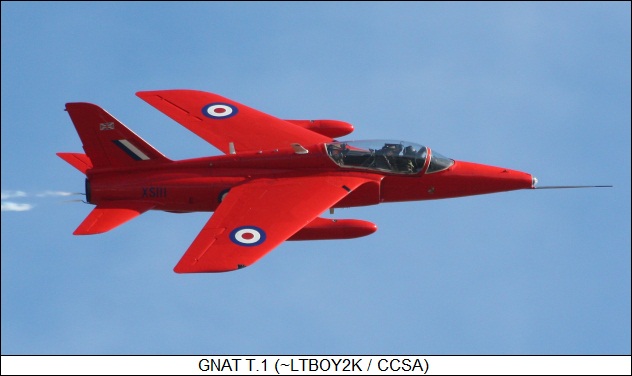
* The following list table provides a production and user summary of the Gnat family:
The actual total may be somewhat less. Some of the aircraft listed here as new-build may have been recycled, and so there may be a bit of "double counting".
BACK_TO_TOP* There were a number of unbuilt Gnat concepts. A navalized Gnat, with the wing of the trainer, plus arresting gear and other carrier kit, was considered briefly. More consideration was given in the mid-1950s to the "Fo.143 Gnat Mark 2", which featured a thinner wing -- 6% thick instead of the 8% thick wing of the standard Gnat fighter -- plus an afterburning Orpheus engine in a longer fuselage, enlarged engine intakes, more internal tankage, and (in maturity) an AI.23 radar system in a fatter nose.
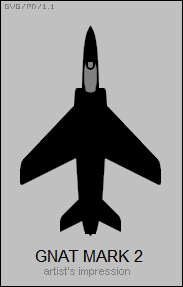
The Gnat Mark 2 would have been capable of Mach 1.28 at altitude and the Air Ministry was interested, with Folland going so far as to build a wing for a prototype. The project went no further, mainly because the RAF still didn't have a requirement for the Gnat, even one that was capable of cracking Mach 1.
Further refinements were considered along such lines. The "Gnat Mark 4" had a redesigned 6% wing, featuring full-span leading-edge slats to improve take-off and landing handling, and a top speed of Mach 1.5. The "Gnat Mark 5" was a series of designs, ultimately featuring twin afterburning Rolls-Bristol RB.153 engines, improved aerodynamics that resulted in only a general resemblance to the original Gnat, and a top speed of Mach 2.4. Nothing came of these notions.
The final and most spectacular redesign was a Mach 2 variable geometry ("swing wing") machine, the Folland "Fo.148", that was intended as a trainer, air superiority fighter, or light strike aircraft. The wings were to have full-span leading-edge slats and slotted trailing edge flaps; there would be a single stores pylon on each side of the fuselage. It was to have been powered by an afterburning RB.153 engine with a thrust reverser. The Fo.148 was said to have been the last aircraft design to bear a Folland designation before the company was absorbed into the Hawker-Siddeley group. It was an interesting design, and it is a bit of shame it never flew.
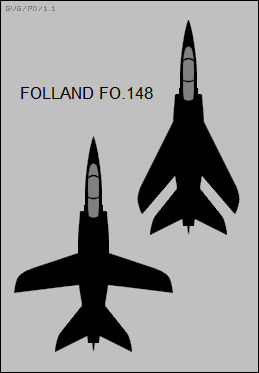
* Sources include:
Various small pieces of information were found in other sources such as JANE'S ALL THE WORLD AIRCRAFT, but no one of them added more than one or two pieces to the puzzle, and so I have not cited them.
* Revision history:
v1.0 / 01 nov 99 v1.1 / 01 sep 00 / Cleanup, minor changes. v1.2.0 / 01 jan 03 / Cosmetic update. v1.2.1 / 01 jan 05 / Review & polish. v1.2.2 / 01 feb 06 / Review & polish. v1.2.3 / 01 jan 08 / Review & polish. v1.2.4 / 01 dec 09 / Review & polish. v1.2.5 / 01 nov 11 / Review & polish. v1.2.6 / 01 oct 13 / Review & polish. v1.2.7 / 01 sep 15 / Review & polish. v1.2.8 / 01 aug 17 / Review & polish. v1.2.9 / 01 jul 19 / Review & polish. v1.3.0 / 01 may 21 / Review & polish. v1.3.1 / 01 apr 23 / Review & polish. v1.3.2 / 01 mar 25 / Review & polish. (!)BACK_TO_TOP
